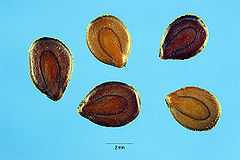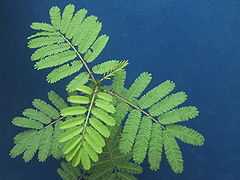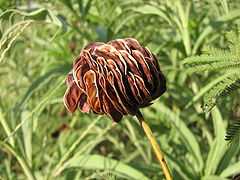Desmanthus
| Desmanthus | |
|---|---|
 | |
| Desmanthus pernambucanus | |
| Scientific classification | |
| Kingdom: | Plantae |
| (unranked): | Angiosperms |
| (unranked): | Eudicots |
| (unranked): | Rosids |
| Order: | Fabales |
| Family: | Fabaceae |
| Subfamily: | Mimosoideae |
| Tribe: | Mimoseae |
| Genus: | Desmanthus Willd.[1] |
| Type species | |
| Desmanthus virgatus (L.) Willd. | |
| Species | |
|
See text. | |
Desmanthus is a genus of flowering plants in the subfamily Mimosoideae of the pea family, Fabaceae. It contains about 24 species of herbs and shrubs that are sometimes described as being suffruiticose and have bipinnate leaves. Desmanthus is closely related to Leucaena and in appearance is similar to Neptunia. Like Mimosa and Neptunia, Desmanthus species fold their leaves in the evening. They are native to Mexico and North, Central and South America.
Description




D. virgatus has a number of common names such as `hedge lucerne' in India, `little mimosa' in Brazil, `bundleflower' in the USA, `leucaena mini' in Indonesia, `dwarf koa', `dais' in Mexico,`donkey bean' and `desmanthus'.
The term "donkey bean" comes from Central America where Desmanthus is highly regarded as a fodder for donkeys which are valued domestic draught animals.
There are considerable differences in the descriptions of Desmanthus in the literature (see Bogdan 1977; Skerman 1977; National Academy of Science 1979; Allen & Allen 1981; Reid 1983; Hacker 1990). For example, Reid (1983) says that Desmanthus virgatus ranges from "leggy" plants in the humid tropics to compact bushes in the semi-arid zones to prostrate in the montane zones; Allen and Allen (1981) state that Desmanthus grows to 3 metres; Hacker (1990) states that D. virgatus is an erect shrub 1.3 metres tall. All these views illustrate the great diversity and polymorphism within the genus and between species.
In the United States, Illinois bundleflower (Desmanthus illinoensis) is the most widely distributed Desmanthus species. The root-bark, which accounts for half of the total weight of the root system, is reported to contain anywhere from 0% to 0.34% DMT and 0.11% N-Methyltryptamine. Alkaloid content is highly variable in this species.[2]
Likewise, root bark of Desmanthus leptolobus has been found to contain N,N-DMT and related tryptamines. While its only reported quantitative analysis was 0.14% (Appleseed), all instances of co-occurrence with D. illinoensis showed it to be noticeably stronger than D. illinoensis, according to co-thin layer chromatography of the root bark.[3]
Uses
In Australia three species of Desmanthus have been released as a pasture legume and many other accessions are being evaluated as pasture species for clay soils. The three released cultivars are:
- Desmanthus virgatus Cultivar "Marc"(Accession number: CPI 78373) which is described as early flowering, decumbent to ascending, growing 30 to 60 cm tall and originates from Argentina.
- Desmanthus leptophyllus Cultivar "Bayamo" (CPI 82285), mid season flowering, ascending type, 95–135 cm tall, from Cuba
- Desmanthus pubescens Cultivar "Uman" (CPI 92803), late flowering, decumbent shrub, taller and wider spreading than Marc, 40–100 cm tall, from Mexico.
In its native range in the US, the Land Institute is selectively breeding it to be a perennial seed crop for human food, in addition to forage / pasture. It offers many of the advantages in terms of nutrition, protein and nitrogen fixation as soybeans or alfalfa, but as a perennial.[4] Perennial crops tend to require less input of chemicals and energy, and less weed control, for comparable or higher yields to annuals in many systems.
Species
|
|
See also
- Psychedelic plants
References
- ↑ "Desmanthus information from NPGS/GRIN". www.ars-grin.gov. Retrieved 2008-04-27.
- ↑ Desmanthus (Ayahuasca: alkaloids, plants & analogs)
- ↑ Ayahuasca: alkaloids, plants & analogs: assembled by Keeper of the Trout
- ↑ http://www.landinstitute.org/vnews/display.v/ART/2007/03/15/45fac62e11c35?in_archive=1
- ↑ "Desmanthus % - ILDIS LegumeWeb". www.ildis.org. Retrieved 2008-04-27.
External links
![]() Media related to Desmanthus at Wikimedia Commons
Media related to Desmanthus at Wikimedia Commons
![]() Data related to Desmanthus at Wikispecies
Data related to Desmanthus at Wikispecies

